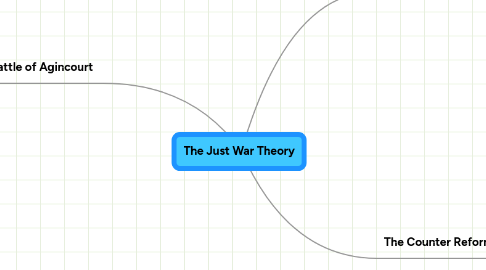
1. The Battle of Agincourt
1.1. Jus ad Bello
1.1.1. 1. Just Cause: King Henry V invaded France after the failure of negotiations with the French
1.1.2. 2. Right Intentions: Purely because of lack of negotiations
1.1.3. 3. Last Resort: War fought was not a last resort; was out of Henry's anger
1.1.4. 4. Proportionality: The casualties (mostly on French side) was not proportionate to the goals of the English
1.2. Jus in Bello
1.2.1. 1. Noncombatant Immunity: The civilians of the port of Harfleur (for example) were attacked
1.2.2. 2. Proportionality: the loss of the French (around 7,000-10,000 killed), especially, (evil) outweighed the good achieved.
1.2.3. 3. Right Intentions: During the assault on the baggage train, King Henry was alarmed after thinking the French would regroup and attack. Henry then slaughtered almost all of the French prisoners
2. The First Crusade
2.1. Jus ad Bello
2.1.1. 1. Right Intention: the actual reason why the Church wanted to regain the Holy Land was because they wanted to control the trade posts to acquire more money.
2.1.2. 2. Last Resort: the Church did not attempt to settle this dispute between the Muslims peacefully; war was not the last resort, but was their first choice
2.1.3. 3. Proportionality: the gain of the Holy Land was not proportional to the lives taken on both sides- by the time the Crusaders reached Jerusalem, they only had 12,000 men left
2.2. Jus in Bello
2.2.1. 1. Noncombatant Immunity: the Muslims were the only group deemed as infidels, yet the Church massacred Jewish communities
2.2.2. 2. Proportionality: the Crusaders used force un-proportionally (ex:massacre of the Jews) which outweighed the "good" achieved in the end
2.2.3. 3. Right Intention: excessive deaths directly connected to the violation Jus ad Bello Right Intentions
3. The Counter Reformation
3.1. Jus ad Bello
3.1.1. 1. Just Cause: it wasn't for the greater good, and only benefited the Catholic Church. There was no prior attack directly inflicted on them that would cause them to justify their attack against
3.1.2. 2. Right Intentions: war was a religious conflict
3.1.3. 3. Proportionality: the aftermath was so devastating that the population living in the German states were reduced 15-30%
3.1.4. 4. Last Resort: the tensions between the Catholic church and the Lutheran church could have been solved a different way (more compromises)
3.2. Jus in Bello
3.2.1. 1. Noncombatant Immunity: many civilians were killed (reduction of population by 15-30%)
3.2.2. 2. Proportionality: the casualties on both sides outweighed the achievement by either sides
3.2.3. 3. Right Intention: excessive deaths directly connected to the violation Jus ad Bello Right Intentions
